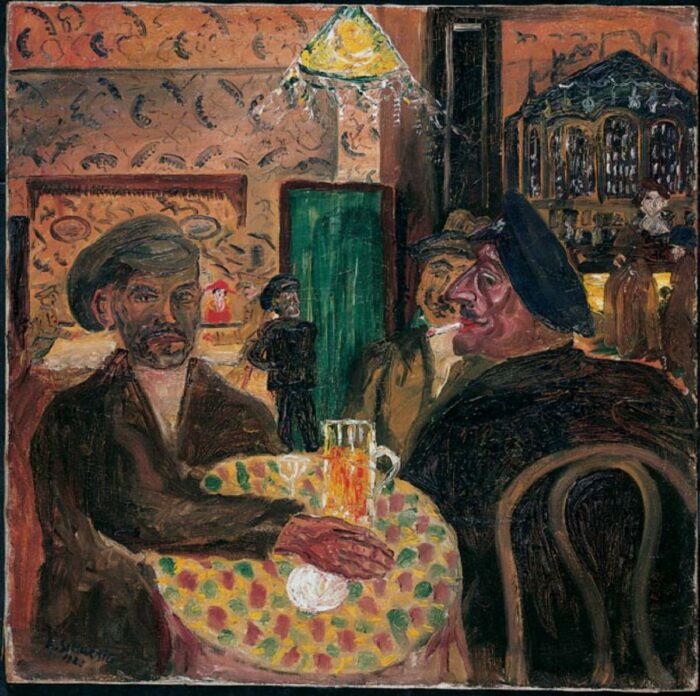Karl Schwesig: The “degenerate” artist

Karl Schwesig fell victim to the SS political purges as early as 1933: He was a member of the Communist Party of Germany, moved in left-wing artists’ circles, and gave shelter to victims of persecution. Karl was imprisoned several times and was also brutally tortured. The National Socialists turned their attention to Karl’s paintings in 1937, branding them as “degenerate” and confiscating and destroying them. He recorded his early arrests and mistreatment in impactful sketches and testimonies.
Karl Schwesig was born on June 19,1898 in Gelsenkirchen into a working-class family. As a child he developed rickets, which stunted his growth, and he was just four and half feet tall. His short stature and poor health saved him from death in the First World War: He was not sent to the front line, and in 1918, after three years of military service in an office, he was able to begin his studies at the Academy of Fine Arts in Düsseldorf. Karl left the Academy after two years without finishing his studies and joined a popular group of avant-garde artists: “Das Junge Rheinland” brought together young, politically committed artists and intellectuals, and allowed Karl to exhibit his work for the first time.


Political art
During his time with “Das Junge Rheinland,” Karl did not only create expressive avant-garde paintings. Together with other artists in the group, he also published a political satire magazine. Karl joined the Communist Party of Germany and in 1930 co-founded the local Düsseldorf branch of “Asso,” an organization of communist artists.
Mistreated and humiliated
In 1933, the Nazi authorities disbanded “Das Junge Rheinland,” labeling the group the “mother of degenerate art.” Many of its members were banned from practicing their profession. Some came to an arrangement with the new government and became recognized artists. Karl, however, distributed pamphlets, helped other victims of persecution by offering them shelter, and quickly came under pressure because of his political stance that he expressed openly. He was arrested for the first time in July 1933 and was detained for several months. He was abused by the SA at “Schlegelkeller,” a torture prison in Düsseldorf, because they wanted to find out the names of his comrades-in-arms in the resistance – and humiliate him as an “intellectual.”
»Because they were deemed dangerous to the state, the three larger paintings (…) had been dragged from my studio to the Schlegelkeller as trophies. Now all the prisoners and SA people were gathered in front of the paintings and forced to watch what was going to happen to the painter of such paintings today.«
Karl Schwesig, „Schlegelbericht“ (Schlegel Account) (1935/36)
Exile in Belgium
Karl’s prison documents at the Arolsen Archives show that he was officially imprisoned in a court jail from August 1933 on the charge of “high treason.” In February 1934, he was convicted by the General Attorney’s Office of “preparing for high treason” and was imprisoned until November 18, 1934. Karl subsequently managed to flee to Belgium where he completed the “Schlegelkeller-Zyklus” containing 48 sketches and texts depicting his experiences as a victim of Nazi torture.

Prints from the “Schlegelkeller-Zyklus” were exhibited in Brussels and Amsterdam in 1936, and in Moscow in 1937. The book “Schlegelkeller” containing the prints and Karl’s account of his torture was not published until 1983 (Foto: Galerie Remmert und Barth, Düsseldorf).
During his exile, Karl was deprived of his German citizenship. This denaturalization document is also stored at the Arolsen Archives. In 1937, the National Socialists confiscated 17 of his works from German museums and destroyed them – just like hundreds of other paintings that had been classified as “degenerate art” by Nazi cultural propaganda.
Return to Germany
In 1940, following the invasion of Belgium by German troops, Karl was again arrested and deported to France. His name appears on a list of people residing in Belgium in May 1940, who were then sent to French prisons. Karl was probably imprisoned continuously until 1945 and was also brought back to Germany by the SS during this time. At the Arolsen Archives, there is only evidence of periods of imprisonment in France in the summer of 1943. Karl survived, returned to Düsseldorf, married, and had three children. He died on June 19, 1955, his 57th birthday.

